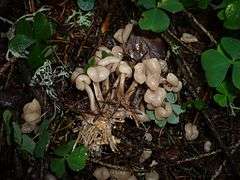Cudonia confusa
Cudonia confusa, commonly known as the cinnamon jellybaby, is a species of fungus in the family Cudoniaceae.[1] The species was first described scientifically in 1898 by Italian mycologist Giacomo Bresadola.[2]
| Cudonia confusa | |
|---|---|
 | |
| Scientific classification | |
| Kingdom: | |
| Division: | |
| Class: | |
| Order: | |
| Family: | |
| Genus: | |
| Species: | C. confusa |
| Binomial name | |
| Cudonia confusa Bres. (1898) | |
Description
The fungus forms slimy or sticky club-shaped fruit bodies up to 3 cm (1.2 in) high with a cinnamon to reddish-brown "head" that measures 7–12 mm (0.28–0.47 in) atop a similarly coloured stalk that is 2–3 cm (0.8–1.2 in) by 1–2 mm (0.04–0.08 in) thick. Its cylindrical spores measure 35–45 by 2 µm; arranged in a parallel fashion,[3] they are borne in asci that measure 105–120 by 10–12 µm.[4] The paraphyses are curled at their tips.[3]
Cudonia circinans is similar in appearance, but its stalk is not the same color as its head.[3]
Habitat and distribution
Cudonia confusa is found in Asia (China[5] and Korea[3]) and Europe, where it usually grows in tufts in coniferous forests.[4]
References
- "Cudonia confusa Bres. (1898)". Mycobank. International Mycological Association. Retrieved 2011-07-06.
- Bresadola G. (1898). "Fungi tridentini". Fungi tridentini novi, vel nondum delineati, descripti, et iconibus illustrati (in Latin). 2 (12–13): 47–81.
- Hong S-W, Jang Y-S. (1987). "Notes on unrecorded fleshy ascomycetes in Korea" (PDF). Korean Journal of Mycology. 15 (2): 76–79. Archived from the original (PDF) on 2012-03-16.
- Phillips R. "Cudonia confusa". Rogers Mushrooms. Archived from the original on 2012-08-23. Retrieved 2011-07-06.
- Zhuang WY. (1998). "A list of discomycetes in China". Mycotaxon. 67: 365–90.